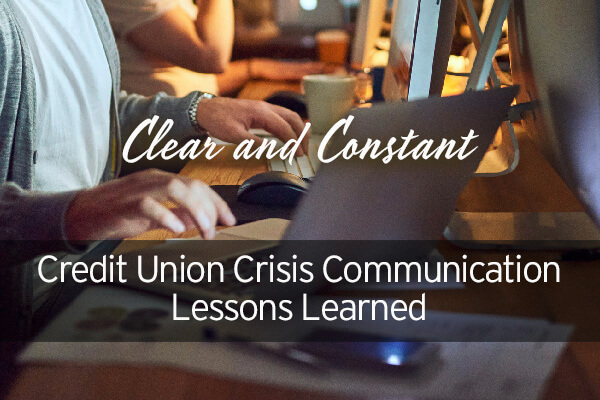It’s human nature to crave information during a time of uncertainty. As emotions and tensions are at the surface, people tend to misinterpret messages. During our crisis (see this article for the back story) we kept the messages very simple, repeated them often and in many different forms – using the available outlets as much as we possibly could.
Membership
Our first goal was to provide our members with the information they were craving, in as many channels as possible. At the time, this credit union had a membership penetration of about 90%. Basically every household was keenly concerned about the availability of their money.
When would the branches open? Were there any working ATMs in the area? These were the urgent questions we needed to answer, and quickly.
Messaging which was clear and constant helped to reduce the stress level for our members and the entire community really.
Money, and access to it, is such a critical element to the well-being of us all. It equals security. And only when we feel secure can we then tackle other issues.
Everyone on our team understood how important our response would be to a quick recovery from the destructive storms. It was definitely a moment, for me at least, which drove home how financial institutions really are a pillar in the strength of a community, on so many different levels.
Leadership Team
We in marketing often work directly with leadership, with our organization’s president, during ‘normal’ operations – crafting talking points for speeches or email, discussing corporate goals, and such. But often those communications might happen through a filter of an admin assistant, or even email – you know how digital communications can ‘filter’ a tone or nuance? It quickly became important for the connection between our president and our marketing leader to be non-filtered and immediate. Phone calls. And that immediate connection was mirrored in how we talked to each other within the marketing team. The management structure got flat very quickly.
Staff
We had one set of team members to handle staff communications and another to handle public communications. That helped tremendously! We kept in touch to make sure the messaging was consistent, but having separate teams also helped the message to be specific to those groups and to get to them disbursed in a more timely manner.
Local Media
Never was our relationship with the local media more important than in this situation. We had always been very open to the media when they requested interviews, comments on financial current events, and such. We also had an advertising relationship of some sorts with them as well. So we knew both the editorial staff and the advertising staff. All of those relationships and contacts came into play as we worked to let the community know what financial services were available and where. Since the information was changing by the hour that first day, and was very dynamic for the following days, close contact was a key to successful communications.
Social Media/Email/Text/Website
Might be hard for some of us to imagine, but social media was in its infancy in 2011, especially for businesses. This Pew Research report shows only about 50% of adults were using social at that time. But we did use it and it worked well for us.
I think it was through this crisis that our board and leadership saw its value and became much more comfortable with it as a tool for communications. Up to that point, the risks seemed much more scary for those in leadership.
We also used our website to disseminate messages. I was so relieved our webmaster had electricity at his house and had access to the website files. We would been scrambling to find a solution if that weren’t the case. Definitely a resource for which redundancy and flexibility is key.
Now there are so many communication channels a financial institution ‘owns’. Use them all – email, text, app, call center on-hold messaging – to reinforce your clarified consistent messages.
Takeaway Tips
- Be quick, clear, and constant with your messaging. Your community is counting on you to provide a source of strength.
- Establish and maintain direct lines of communication (phone calls are preferred) with your leadership. The less filters there are the better.
- Be mindful of communicating with staff. If HR is handling that aspect, maintain clear and open lines of communications with them so messaging for staff and members is in sync.
- Stay in close contact with local media, both editorial and advertising contacts. Be available when they request info and interviews. Provide them easy-to-digest-information when you need to disseminate updates.
- Use your own channels (website, email, app, call center on hold messaging, etc.) as often as you can. Use other channels (social media) as well, just remember it is not as reliable for reaching people.
- Hang in there! This will be hard, but you will shine in this moment of uncertainty!
If you have specific questions, challenges, concerns, please let me know (256-714-6596) or learnmore@jbcommunicationsgroup.com. I’ll do what I can to lighten your load, whether it’s our services or those from another provider.


